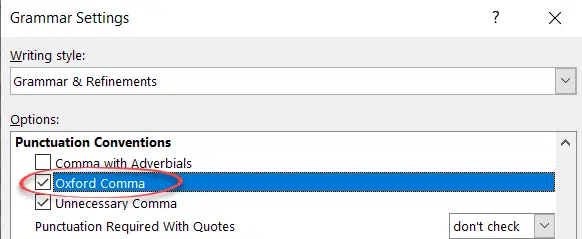Word can warn you about the ‘Oxford’ or serial comma’ whether you prefer to use the extra comma or not. It’s a feature in the latest Word 365 and Word 2021/2019 way back to Word XP (2002).
The Oxford comma is one of those grammatical things that most people don’t worry about but can get others soooo excited. It’s a question of whether to add a comma at the end of a list for example:
Word, Excel, PowerPoint and Outlook
OR the Oxford comma version …
Word, Excel, PowerPoint, and Outlook
Wikipedia has some good examples of where the ‘extra’ comma makes the meaning clear. For example “To my parents, Ayn Rand and God. ” could imply that the parents’ names are Ayn Rand and the Almighty. Adding a comma can eliminate that (unlikely) possibility.
But to others the extra comma is a question of style or clarity. One point-of-view is to use the extra comma only when it’s needed for clarity. Style Guides vary on the Oxford Comma.
Microsoft Word has had Oxford comma checks ever since Word 2002 (XP). The only thing that’s changed is the settings location.
Word 365, Word 2021, 2019 and 2016
File | Options | Proofing | Writing Style | Settings then scroll down a long list to Punctuation Conventions.

Oxford Comma – check this box to enforce the comma in lists. A missing Oxford Comma will show a red dashed line with the suggestion “A comma before “and” or “or” could make this clearer.”

Word 2013, Word 2010, Word 2007
Word 2007, Word 2010 and Word 2013: File | Options | Proofing | Writing Style | Settings | Grammar Only | Require.
The default setting is ” Don’t check ” which is why most people don’t even realize Word can check for Oxford/serial commas.
The other choices are:
Always: Oxford/Serial comma preferred. Warn if there is NOT an extra comma
Never: Oxford/Serial comma NOT required. Warn if there IS an extra comma
Word 2003 and Word XP (2002)
In Word 2002 and Word 2003: Tools | Options | Spelling and Grammar | Settings.
How does Word’s Grammar check work in practice? We tried some examples with the comma setting on and off. The results aren’t what you might expect. Tested with Word US English dictionary. The Oxford comma sentences are in orange.
Correction: The last isn’t strictly an Oxford Comma example, even thought the Word grammar system complains about it when ‘Never’ is selected.
On the left ‘Always’ examples, only the first Warren Zevon quote gets a blue squiggly line. It seems to us that all four lines with black text should get marked by Word’s grammar checker when ‘Always’ is chosen.
On the right, the orange lines should be marked as wrong (blue squiggly line). They are but not for the famous Superman saying. Whether Word is correct is an debatable point.
The ‘Lynne Truss’ example is a bug. If the last two sentences are wrong in the ‘Never’ example then their ‘non comma’ versions on the left should be wrong when the setting is reversed. That doesn’t happen which looks wrong.
Grammar checking in English is hard and the software does a remarkable but imperfect job. The moral of this, like all Word Grammar checks, is that the feature isn’t perfect and is no substitute for proof reading. A mistake that Office Watch is all too aware of .
See Also
- Removing words from the Word dictionary
- Do you help Microsoft’s proofing tools?
- Changing languages that come with Office
- Adding repeating words or phrases to the custom dictionary
- Word in the 2004 US Election
- Take grammatical responsibility

